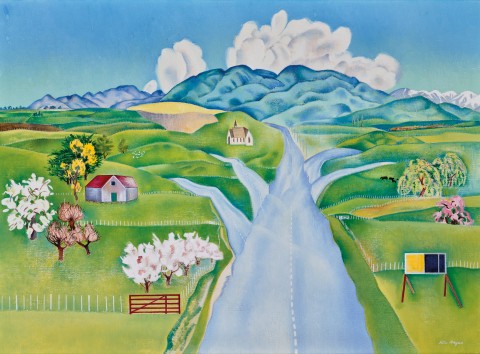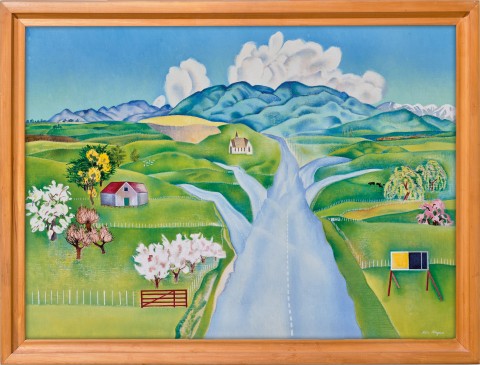HAWKE'S BAY LANDSCAPE, c.1955
RITA ANGUS
oil on canvas board
55.5 x 75.5 cm
signed lower right: Rita Angus
Mrs N. E Bowater, Christchurch, acquired in the 1950s
Private collection, Christchurch, acquired from the above c.1960
Thence by descent
Private collection, Melbourne
Possibly: The Group Show, The Art Gallery, Durham Street, Christchurch, 12 – 27 October 1957, cat. 43 (as ‘Main Route’)
220125.jpg
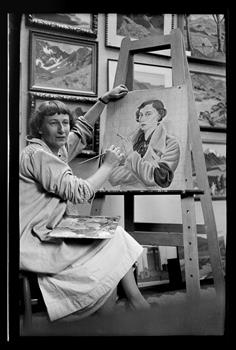
A road cuts through farmland, with neatly fenced paddocks giving way to rolling hills and distant mountains. No people are visible, but the human presence is implied by a shed, a church, and an array of exotic trees, bursting into flower. A hoarding on the right, devoid of text or image, recalls an abstract painting. But it is the road itself which captures our attention – a vertical axis placed just off-centre, sprouting strange, tentacle-like arms that disappear into rural valleys. It is awkward and almost naïve in treatment, and it gives the painting an eerie, otherworldly quality.
Such disruption is typical of Rita Angus’s art. She was never afraid to experiment with scale, imagery and perspective, and the results could be startling. Here, the road evokes an ancient creature embedded in the land, suggesting the turbulent forces buried in its depth. Angus’s family had experienced the 1931 Hawke’s Bay earthquake, which devastated the city of Napier, and she had sketched among its ruins in the following year. She knew the power and unpredictability of this landscape. She also had a strong sense of the interconnectedness of all things – human beings, birds and animals, and the land itself – and a mystical intensity pervades her work.
Rita Angus is one of the most important figures in 20th century New Zealand art, and is beginning to achieve wider recognition. In September 2020, she was scheduled to have a major exhibition at the Royal Academy in London – a project unfortunately cancelled, just months before it was due to open, as a consequence of the global pandemic. That exhibition, Rita Angus: A New Zealand Modernist – He Ringatoi Hou o Aotearoa, was recently shown at the Museum of New Zealand Te Papa Tongarewa.
In his essay for the exhibition catalogue, Royal Academy curator, Adrian Locke, described Angus as ‘a notable maverick in a male-dominated cultural sector’: an artist who pioneered a new visual language in the 1930s, reflecting the values of young, liberal, intellectual New Zealanders.1 While a previous generation had looked to England and Europe, studying abroad and even becoming expatriates, Angus and her contemporaries, such as Colin McCahon, had a keen sense of themselves as New Zealand artists, committed to the cultural development of their country.
Born in Hastings in Hawke’s Bay in 1908, Angus studied at Canterbury College School of Art in Christchurch, where she was part of a lively generation of students who challenged the precepts of their conservative training. Her friend Louise Henderson described her as ‘a very bright young woman, very sure of herself … very interested in the modern movement in painting.’2 Her art flourished during the 1930s, when she painted friends and family, and a series of playful, inventive self-portraits, including an image of herself as Cleopatra. In landscape, she developed a regionalist style, adopting some of the tenets of modern art, such as bold design, simplified form and decorative colour to revitalise the local tradition. Cass (1936), voted New Zealand’s greatest painting by viewers of a popular television show in 2006, epitomises this phase of her work.3
Fog Hawkes Bay HIGH RES.jpg
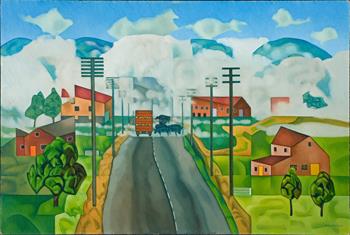
During the 1940s, devastated by the horrors of the Second World War, and recovering from an unhappy love affair with the composer Douglas Lilburn, Angus developed a distinctive, visionary style to express her feminist and pacificist convictions. Living alone in a cottage near Christchurch, and deeply invested in her art, she became increasingly reclusive, working for years to bring her major oils to completion. For most of the decade she refused to sell her work, preferring to live frugally on a small allowance from her parents. She wrote of the ‘single belief’ that sustained her: ‘that artists have significance and depth of meaning in the world. To me, especially in New Zealand. Thus, I have been able to devote my energies to what I really am, a woman painter. It is my life.’4
After recovering from a breakdown in 1949, Angus returned to painting with a greater focus on landscape. She began to sell her work, mainly in group exhibitions, but there was little market for New Zealand art and her earnings were negligible. In 1955 she settled in the capital city, Wellington, and began to make regular bus trips to Napier in Hawke’s Bay to visit her parents. She loved the landscape of the Hawke’s Bay hinterland – a glowing patchwork of fertile farmland, giving way to majestic tawny hills, often snow-tipped in winter. On the bus, she preferred to sit at the front, across from the driver, where she could watch the ever-changing panorama of the landscape. Never without a sketchbook, she made quick sketches of anything that took her eye – farm buildings, a stand of trees, sheep grazing in a paddock. Back in her Wellington studio, these sketches were the starting point for a series of oils which present a highly distinctive view of the Hawke’s Bay landscape.
Angus completed her first oils of the region in the mid-1950s – two small, lively images of flooded paddocks, each featuring farm buildings and a carefully positioned church.5 This landscape is more tranquil, and considerably larger; at 555 x 755mm it appears to be her biggest oil of the decade. Ten years later Angus would revisit this subject – the view from the bus – in paintings such as Fog, Hawke’s Bay (1966 – 68), which reflect her interest in a modified cubism.
d998d41ea6e37a2ff6dce784f9a505587631eef8.jpg
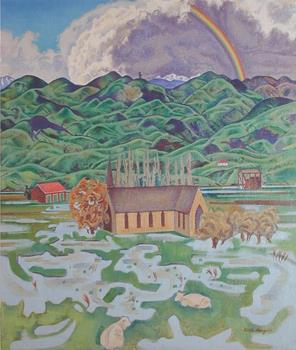
While this work is clearly a Hawke’s Bay subject, its title is undocumented. According to the current owner, it was originally purchased from The Group, an independent Christchurch exhibition society, by a Mrs N.E. Bowater in the 1950s. Angus exhibited only a handful of oils at The Group during that decade, and a review of the exhibition catalogues suggests that this painting is most likely to be Main Route, exhibited in 1957 for what was then her top price of 15 guineas. However, no documentation has been found to confirm this, either in the partial records of The Group or Angus’s own papers.6
When Angus died of cancer in January 1970, aged 62, most of her paintings were still in her possession. Some 620 works were deposited on long-term loan at the National Art Gallery (now the Museum of New Zealand Te Papa Tongarewa), where they soon began to attract scholarly attention, leading to the first major exhibition of her work in 1982. Today, it is only rarely that a new painting comes to light – one which has never been published. In that respect, this Hawke’s Bay landscape is a significant discovery – a luminous, beguiling image, and a fascinating example of the artist’s work.
1. Adrian Locke, ‘The other side of the easel: Rita Angus and other women artists on the edge,’ in Lizzie Bisley (ed), Rita Angus: New Zealand modernist/He ringatoi hou o Aotearoa, Te Papa Press, 2021, p. 62.
2. Quoted in Kaleidoscope, Television New Zealand, 1983.
3. Frontseat, Television New Zealand, 2006.
4. Letter to Douglas Lilburn, 29 December 1945. Alexander Turnbull Library, MS-Papers-7623-59.
5. Flood, Hawke’s Bay (1955), oil on canvas, 452 x 485mm, Museum of New Zealand Te Papa Tongarewa;
Flood, Hawke’s Bay (c.1955-56), oil on canvas, 413 x 350 mm, Wallace Arts Trust.
6. The archive of The Group is held at Christchurch Art Gallery (https://christchurchartgallery.org.nz/media/uploads/2010_07/The_Group.pdf), but the records for 1957
are minimal. Angus’s papers at the Alexander Turnbull Library contain some receipts (see MS-Papers 1399-3/5;
3/7; 2/3/1-4; and 2/3/5-10), but again the documentation is incomplete.
JILL TREVELYAN
Jill Trevelyan is a Wellington art historian and curator. She is the author of the highly acclaimed biography, Rita Angus: An Artist’s Life (Te Papa Press, Wellington, 2008), which won the Non Fiction Award at the Montana New Zealand Book Awards in 2009, and was reprinted in the context of the recent Rita Angus exhibition held at the Museum of New Zealand Te Papa Tongarewa, Wellington. She also contributed to the catalogue accompanying that exhibition, Rita Angus: A New Zealand Modernist – He Ringatoi Hou o Aotearoa (Te Papa Press, Wellington, 2021), and is the co-author of Rita Angus: Live to Paint & Paint to Live (Random House, Wellington, 2001).
